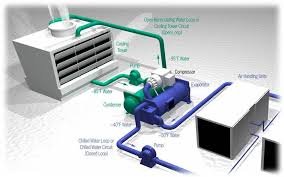What are the fundamental principles of an HVAC system and its key components?

Fundamental Principles of an HVAC System
An HVAC (Heating, Ventilation, and Air Conditioning) system is designed to provide a comfortable indoor environment by controlling temperature, humidity, air quality, and air circulation. These systems are essential in both residential and commercial buildings, as well as in industries that require strict environmental control, like pharmaceutical manufacturing.
The fundamental principles of an HVAC system can be broken down into its three main functions:
-
Heating: This process involves raising the temperature of a space to maintain comfort or meet specific environmental requirements. It can be achieved using various heat sources, such as boilers, heat pumps, or electric heaters.
-
Ventilation: Ventilation is the exchange of indoor air with outdoor air to maintain air quality. It helps remove contaminants, control humidity levels, and provide a fresh supply of oxygen. This can be accomplished through mechanical systems (such as exhaust fans or supply air systems) or natural ventilation (through open windows or vents).
-
Air Conditioning (Cooling): Air conditioning involves removing heat from indoor air and replacing it with cooler air. It also controls humidity levels, ensuring that the air remains comfortable and breathable. This process is typically done through refrigerants, evaporator coils, and compressors.
Key Components of an HVAC System
An HVAC system consists of multiple interconnected components, each playing a critical role in achieving the desired environmental conditions. These components can be divided into three main categories based on the principle they serve:
1. Heating Components
-
Furnace: The furnace is the core component responsible for heating the air. It typically uses natural gas, propane, or electricity to generate heat and distributes it through ducts or pipes.
-
Boiler: Boilers use water or steam to transfer heat throughout the building. Water is heated and circulated via pipes to radiators or underfloor heating systems.
-
Heat Pump: A heat pump works like an air conditioner in reverse. It extracts heat from outside (even in cold weather) and brings it inside to heat the space. In the summer, the cycle reverses to cool the space.
2. Ventilation Components
-
Air Handlers: These are devices that take in the air, filter it, and then heat or cool it before distributing it through the duct system. They usually include a blower to push air through the ducts and can have additional features like humidity control.
-
Exhaust Fans: These fans remove stale air, moisture, or pollutants from specific areas such as kitchens, bathrooms, or industrial settings.
-
Ductwork: The duct system is the network of pipes or conduits that transport air from the HVAC system to different parts of the building. It can be made of sheet metal, fiberglass, or flexible materials.
-
Ventilation Fans: Used to ensure air circulates efficiently within a building, maintaining a fresh airflow and preventing the buildup of pollutants or heat.
3. Air Conditioning Components
-
Compressor: The compressor is a vital component that compresses refrigerant gas and pumps it through the system. The refrigerant carries heat from the indoor air to the outside.
-
Condenser: The condenser cools and condenses the refrigerant gas back into a liquid. It is usually located outside the building, where heat can be released into the outdoor air.
-
Evaporator Coil: The evaporator absorbs heat from the indoor air, cooling it. As the refrigerant passes through the evaporator, it evaporates, pulling heat out of the air and cooling it.
-
Expansion Valve: This device regulates the flow of refrigerant into the evaporator coil, ensuring the correct pressure and temperature for efficient heat exchange.
4. Control Components
-
Thermostat: A thermostat is used to monitor and regulate the temperature inside the building. It communicates with the HVAC system to maintain the desired temperature, activating heating or cooling as needed.
-
Sensors and Dampers: These are used to regulate airflow and maintain specific environmental conditions. Sensors can detect temperature, humidity, and air quality, while dampers control the flow of air through the ducts.
How These Components Work Together
-
Heating: When the thermostat detects a temperature drop, it sends a signal to the furnace or boiler to generate heat. The air handler or duct system circulates the heated air or water to the desired areas.
-
Ventilation: Fresh air is brought in from outside through ventilation ducts and air handlers, while stale or contaminated air is expelled through exhaust fans or vents. The system ensures that air quality remains optimal by controlling humidity and filtering pollutants.
-
Cooling: In warmer conditions, the thermostat will activate the air conditioning components. The compressor pushes refrigerant through the system, where heat is absorbed from the indoor air and released outside via the condenser. The evaporator cools the indoor air by removing heat, and the cycle continues.
Conclusion
An HVAC system works as an integrated network designed to keep the indoor environment comfortable, healthy, and safe. Each component serves a vital role in ensuring the system operates efficiently. By managing temperature, ventilation, and air quality, HVAC systems play a central role in both residential and industrial spaces, helping maintain ideal environmental conditions for comfort and productivity.
🎓 Discover one of the best Pharmaceutical Production courses available — click below to explore the course that’s shaping future Production skills.

